Testing the efficacy and toxicity of adenylyl cyclase inhibitors against enteric pathogens using in vitro and in vivo models of infection
- PMID: 20123712
- PMCID: PMC2849411
- DOI: 10.1128/IAI.01114-09
Testing the efficacy and toxicity of adenylyl cyclase inhibitors against enteric pathogens using in vitro and in vivo models of infection
Abstract
Enterotoxigenic Escherichia coli (ETEC) produces the ADP-ribosyltransferase toxin known as heat-labile enterotoxin (LT). In addition to the toxic effect of LT resulting in increases of cyclic AMP (cAMP) and disturbance of cellular metabolic processes, this toxin promotes bacterial adherence to intestinal epithelial cells (A. M. Johnson, R. S. Kaushik, D. H. Francis, J. M. Fleckenstein, and P. R. Hardwidge, J. Bacteriol. 191:178-186, 2009). Therefore, we hypothesized that the identification of a compound that inhibits the activity of the toxin would have a suppressive effect on the ETEC colonization capabilities. Using in vivo and in vitro approaches, we present evidence demonstrating that a fluorenone-based compound, DC5, which inhibits the accumulation of cAMP in intoxicated cultured cells, significantly decreases the colonization abilities of adenylyl cyclase toxin-producing bacteria, such as ETEC. These findings established that DC5 is a potent inhibitor both of toxin-induced cAMP accumulation and of ETEC adherence to epithelial cells. Thus, DC5 may be a promising compound for treatment of diarrhea caused by ETEC and other adenylyl cyclase toxin-producing bacteria.
Figures
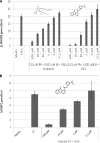
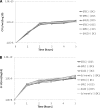
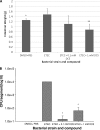
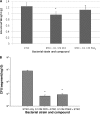
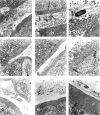


Similar articles
-
Development of protective egg yolk immunoglobulins (IgY) targeting CfaB, LTB, and EtpA recombinant proteins of Enterotoxigenic Escherichia coli (ETEC) for inhibiting toxin activity and bacterial adherence.Braz J Microbiol. 2025 Mar;56(1):403-413. doi: 10.1007/s42770-024-01554-0. Epub 2024 Nov 6. Braz J Microbiol. 2025. PMID: 39500826
-
Escherichia coli K88ac fimbriae expressing heat-labile and heat-stable (STa) toxin epitopes elicit antibodies that neutralize cholera toxin and STa toxin and inhibit adherence of K88ac fimbrial E. coli.Clin Vaccine Immunol. 2010 Dec;17(12):1859-67. doi: 10.1128/CVI.00251-10. Epub 2010 Oct 27. Clin Vaccine Immunol. 2010. PMID: 20980482 Free PMC article.
-
A tripartite fusion, FaeG-FedF-LT(192)A2:B, of enterotoxigenic Escherichia coli (ETEC) elicits antibodies that neutralize cholera toxin, inhibit adherence of K88 (F4) and F18 fimbriae, and protect pigs against K88ac/heat-labile toxin infection.Clin Vaccine Immunol. 2011 Oct;18(10):1593-9. doi: 10.1128/CVI.05120-11. Epub 2011 Aug 3. Clin Vaccine Immunol. 2011. PMID: 21813665 Free PMC article.
-
Current Progress in Developing Subunit Vaccines against Enterotoxigenic Escherichia coli-Associated Diarrhea.Clin Vaccine Immunol. 2015 Sep;22(9):983-91. doi: 10.1128/CVI.00224-15. Epub 2015 Jul 1. Clin Vaccine Immunol. 2015. PMID: 26135975 Free PMC article. Review.
-
Progress and hurdles in the development of vaccines against enterotoxigenic Escherichia coli in humans.Expert Rev Vaccines. 2012 Jun;11(6):677-94. doi: 10.1586/erv.12.37. Expert Rev Vaccines. 2012. PMID: 22873126 Review.
Cited by
-
Heat-labile enterotoxin-induced activation of NF-κB and MAPK pathways in intestinal epithelial cells impacts enterotoxigenic Escherichia coli (ETEC) adherence.Cell Microbiol. 2012 Aug;14(8):1231-41. doi: 10.1111/j.1462-5822.2012.01793.x. Epub 2012 Apr 16. Cell Microbiol. 2012. PMID: 22452361 Free PMC article.
-
Structure-based redesign of an edema toxin inhibitor.Bioorg Med Chem. 2012 Jan 1;20(1):368-76. doi: 10.1016/j.bmc.2011.10.091. Epub 2011 Nov 16. Bioorg Med Chem. 2012. PMID: 22154558 Free PMC article.
-
Alternative pre-approved and novel therapies for the treatment of anthrax.BMC Infect Dis. 2016 Nov 3;16(1):621. doi: 10.1186/s12879-016-1951-y. BMC Infect Dis. 2016. PMID: 27809794 Free PMC article. Review.
-
Repurposing approved drugs on the pathway to novel therapies.Med Res Rev. 2020 Mar;40(2):586-605. doi: 10.1002/med.21627. Epub 2019 Aug 20. Med Res Rev. 2020. PMID: 31432544 Free PMC article. Review.
-
Pharmacophore selection and redesign of non-nucleotide inhibitors of anthrax edema factor.Toxins (Basel). 2012 Nov 8;4(11):1288-300. doi: 10.3390/toxins4111288. Toxins (Basel). 2012. PMID: 23202316 Free PMC article. Review.
References
-
- Arnold, J. W., G. R. Klimpel, and D. W. Niesel. 1993. Tumor necrosis factor (TNF alpha) regulates intestinal mucus production during salmonellosis. Cell. Immunol. 151:336-344. - PubMed
-
- Chen, D. L., G. Menche, T. D. Power, L. Sower, J. W. Peterson, and C. H. Schein. 2007. Accounting for ligand-bound metal ions in docking small molecules on adenylyl cyclase toxins. Proteins 67:593-605. - PubMed
-
- Eaves-Pyles, T., C. A. Allen, J. Taormina, A. Swidsinski, C. B. Tutt, G. E. Jezek, M. Islas-Islas, and A. G. Torres. 2008. Escherichia coli isolated from a Crohn's disease patient adheres, invades, and induces inflammatory responses in polarized intestinal epithelial cells. Int. J. Med. Microbiol. 298:397-409. - PubMed
Publication types
MeSH terms
Substances
Grants and funding
LinkOut - more resources
Full Text Sources
Other Literature Sources
Medical

